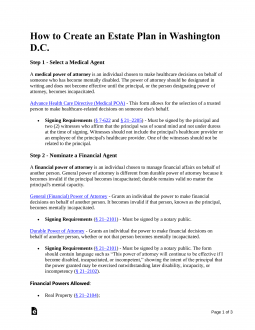Updated March 17, 2024
A Washington D.C. estate planning checklist is a guide for residents of the District of Colombia who have not yet made end-of-life decisions related to their health and their assets. The checklist covers every facet of estate planning, from nominating someone to make healthcare-related decisions for a person who becomes incapacitated to drafting a will. To nominate someone to make medical decisions on behalf of someone else, refer to the Medical Power of Attorney section, and to select an individual to manage financial affairs, refer to the General and Durable Power of Attorney pages. To determine how to direct the distribution of assets after death, see the Last Will and Testament and Revocable Living Trust sections.
How to Create an Estate Plan in Washington D.C. (6 steps)
- Select a Medical Agent
- Nominate a Financial Agent
- Make a List of Assets
- Select Beneficiaries
- Draft a Will or Trust
- Safely Store Documents
1. Select a Medical Agent
Advance Health Care Directive (Medical POA) – This form allows for the selection of a trusted person to make healthcare-related decisions on someone else’s behalf.
- Signing Requirements – Must be signed by the principal and two (2) witnesses who affirm that the principal was of sound mind and not under duress at the time of signing. Witnesses should not include the principal’s healthcare provider or an employee of the principal’s healthcare provider. One of the witnesses should not be related to the principal.[1][2]
2. Nominate a Financial Agent
A financial power of attorney is an individual chosen to manage financial affairs on behalf of another person. General power of attorney is different from durable power of attorney because it becomes invalid if the principal becomes incapacitated; durable remains valid no matter the principal’s mental capacity.
General (Financial) Power of Attorney – Grants an individual the power to make financial decisions on behalf of another person. Generally, it becomes invalid if that person, known as the “principal,” becomes incapacitated.
- Signing Requirements – Must be signed before a notary public.[3]
Durable Power of Attorney – Grants an individual the power to make financial decisions on behalf of the principal, even if the principal becomes incapacitated.
- Signing Requirements – A power of attorney must be signed by the principal or by an authorized individual on behalf of the principal.[4] In addition, the principal must sign before a notary public.[5]
Financial Powers Allowed:
- Real Property[6]
- Tangible Personal Property[7]
- Stocks and Bonds[8]
- Commodities and Options[9]
- Banks and Other Financial Institutions[10]
- Operation of Entity or Business[11]
- Insurance and Annuities[12]
- Estates, Trusts, and Other Beneficial Interests[13]
- Claims and Litigation[14]
- Personal and Family Maintenance[15]
- Benefits from Government Programs or Military Service[16]
- Retirement Plans[17]
- Taxes[18]
- Gifts[19]
3. Make a List of Assets
4. Select Beneficiaries
5. Draft a Will or Trust
To dictate their wishes regarding the distribution of their estate, most people use the following two forms:
Last Will and Testament (‘Will’) – A will is a legal document that directs the administration of a person’s estate. The person who drafts the will, known in legal parlance as the testator, uses the will to specify which beneficiary should receive which assets. Upon the testator’s death, the will goes through the probate courts before an estate’s assets are distributed.
- Signing Requirements – Must be signed by the testator and attested to by at least two credible witnesses. No notarization required.[20]
Revocable Living Trust – A revocable living trust is a mechanism for holding assets. The principal, known as the grantor, can designate a trustee to manage the assets according to express written instructions. A revocable trust can be amended or revoked by the grantor.
- Signing Requirements – A certificate of trust should be delivered to the mayor for filing.[21]
Washington D.C. Estate Planning Laws
- Financial Power of Attorney – D.C. Code, Title 21, Chapter 26
- Medical Power of Attorney – § 21–2205
- Last Will and Testament – D.C. Code, Title 18
- Revocable Living Trust – D.C. Code, Title 19, Chapter 13, Subchapter VI


